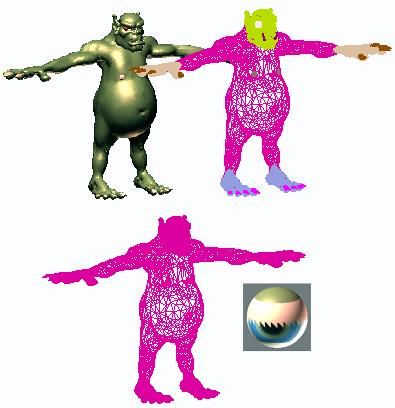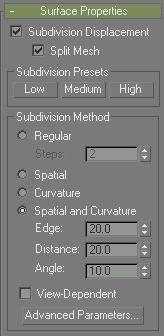
Select an editable mesh object or object with the Edit Mesh modifier applied. > Modify panel
Select an editable mesh object. > Quad menu > Tools 1 quadrant > Sub-Objects sub-menu > Top Level
Editable Mesh (Object) functions are available when no sub-object levels are active. These functions are also available at all sub-object levels, and work the same in each mode, except as noted below.
Interface
Edit Geometry rollout

Attach: Lets you attach another object in the scene to the selected mesh. You can attach any type of object, including splines and patch objects. Attaching a non-mesh object converts it to a mesh. Click the object you want to attach to the currently selected mesh object.
When you attach an object, the materials of the two objects are combined in the following way:
If the object being attached does not have a material assigned, it inherits the material of the object it is being attached to.
Likewise if the object you're attaching to doesn't have a material, it inherits the material of the object being attached.
If both objects have materials, the resulting new material is a multi/sub-object material that encompasses the input materials. A dialog appears offering three methods of combining the objects' materials and material IDs. For more information, see Attach Options Dialog.
Attach remains active in all sub-object levels, but always applies to objects.
Attach List: Lets you attach other objects in the scene to the selected mesh. Click to display a Select By Name dialog where you choose multiple objects to attach.

Shaded view of model (upper left); wireframe view of model (upper right); model with objects attached (lower left); and subsequent sub-object material (lower right)
Explode group
Explode: Breaks up the current object into multiple elements or objects based on the angles of its edges. This function is available in Object mode as well as all sub-object levels except Vertex and Edge.
The angle threshold spinner, to the right of the Explode button, lets you specify the angle between faces below which separation will not occur. For example, all sides of a box are at 90-degree angles to each other. If you set the spinner to 90 or above, exploding the box changes nothing. However, at any setting below 90, the sides all become separate objects or elements.
To: Objects/Elements: Specifies whether the exploded faces become the separate objects or elements of the current object.
Remove Isolated Vertices: Deletes all isolated vertices in the object regardless of the current selection.
View Align: Aligns all vertices in selected objects to the plane of the active viewport. If a sub-object level is active, this function affects only selected vertices or those belonging to selected sub-objects.
In the case of orthographic viewports, using View Align has the same effect as aligning to the construction grid when the home grid is active. When aligning to a perspective viewport (including camera and light views), the vertices are reoriented to be aligned to a plane that is parallel to the camera’s viewing plane. This plane is perpendicular to the view direction that is closest to the vertices’ average position.
Grid Align: Aligns all vertices in selected objects to the plane of the current view. If a sub-object level is active, function aligns only selected sub-objects.
This function aligns the selected vertices to the current construction plane. The current plane is specified by the active viewport in the case of the home grid. When using a grid object, the current plane is the active grid object.
Surface Properties rollout

Note: The Surface Properties rollout is available only for editable mesh objects; it does not appear in the Modify panel for an object to which the Edit Mesh modifier is applied.
Subdivision Displacement: When on, the program subdivides faces to accurately displace the mesh, using the method and settings you specify in the Subdivision Presets and Subdivision Method group boxes. When off, the program displaces the mesh by moving existing vertices, the way the Displace modifier does. Default=off.
Split Mesh: Affects the seams of displaced mesh objects; also affects texture mapping. When on, the program splits the mesh into individual faces before displacing them; this helps preserve texture mapping. When off, the program uses an internal method to assign texture mapping. Default=On.
Tip: This parameter is required because of an architectural limitation in the way displacement mapping works. Turning Split Mesh on is usually the better technique, but it can cause problems for objects with clearly distinct faces, such as boxes, or even spheres. A box's sides might separate as they displace outward, leaving gaps. And a sphere might split along its longitudinal edge (found in the rear for spheres created in the Top view) unless you turn off Split Mesh.
Subdivision Presets and Subdivision methods groups
The controls in these two groups specify how the program applies the displacement map when Subdivision Displacement is turned on.
Subdivision Presets
Lets you choose a preset low, medium, or high quality surface approximation. While a preset is chosen, the values it uses are displayed on the Subdivision Method rollout.
Low: Selects a (comparatively) low-quality surface approximation. These are the default values:
Viewports, Base Surface:
Method=Spatial and Curvature
Edge=50.0
Distance=50.0
Angle=50.0
Merge=0.0
Advanced Parameters > Minimum=0, Maximum=3
Medium: (The default for viewports.) Selects a medium-quality surface approximation. These are the default values:
Viewports, Base Surface:
Method=Spatial and Curvature
Edge=20.0
Distance=20.0
Angle=15.0
Merge=0.0
Advanced Parameters > Minimum=0, Maximum=3
High: Selects a high-quality surface approximation. These are the default values:
Viewports, Base Surface:
Method=Spatial and Curvature
Edge=5.0
Distance=15.0
Angle=10.0
Merge=0.0
Advanced Parameters > Minimum=0, Maximum=3
Subdivision Method group
The controls in this group affect the display of the surface in the viewports. Generally speaking, if the preset values you have chosen give good results, you don't need to adjust the controls on this group. Adjust them if you encounter problems with the preset alternative.
Tip: Choose the method that gives the result you need. If you use modifiers heavily, Spatial might be better than Curvature, because of their regular tessellation. Curvature-dependent tessellation can cause problems with some modifiers.
Regular: Generates a fixed tessellation across the surface based on the Steps parameter. Increasing Steps increases accuracy at a cost of speed, and vice versa, but in general this can be the quickest and least accurate way to approximate a surface.
Spatial: Generates a uniform tessellation made of triangular faces.
The Edge parameter specifies the maximum length of a triangular face in the tessellation. The value is a percentage of the object's bounding box. Decreasing this value increases accuracy.
Curvature: Generates a variable tessellation based on the curvature of the surface. The tessellation has a finer grain where the surface is more curved. Changing surface curvature dynamically changes the curvature tessellation.
The Distance parameter specifies how far the approximation can deviate from the actual surface. Distance is a percentage of the diagonal of each surface's bounding box. Each surface in an object is tessellated based on its size, independently of other surfaces. Scaling a surface doesn't change its tessellation. Decreasing this value increases accuracy. When you set Distance to 0.0, the software ignores this parameter and uses the Angle to control accuracy.
The Angle parameter specifies the maximum angle between faces in the approximation. Decreasing this value increases accuracy. When you set Angle to 0.0, the software ignores this parameter and uses Distance to control accuracy.
When both Distance and Angle are 0.0, the surfaces degenerate and can become flat surfaces.
Spatial and Curvature: Combines the spatial (edge-length) method and the curvature (distance and angle) methods, using all three values.
The Edge parameter specifies the maximum length of a triangular face in the tessellation. The value is a percentage of the object's bounding box. Decreasing this value increases accuracy. When you set Edge to 0.0, the effect is equivalent to the Curvature method.
The Distance parameter specifies how far the approximation can deviate from the actual surface. Distance is a percentage of the diagonal of each surface’s bounding box. Each surface in an object is tessellated based on its size, independently of other surfaces. Scaling a surface doesn’t change its tessellation. Decreasing this value increases accuracy. When you set Distance to 0.0, the software ignores this parameter and uses the Edge and Angle values to control accuracy.
The Angle parameter specifies the maximum angle between faces in the approximation. Decreasing this value increases accuracy. When you set Angle to 0.0, the software ignores this parameter and uses the Edge and Distance values to control accuracy.
When Distance, Angle, and Edge are all 0.0, the surfaces degenerate and can become flat surfaces.
View-Dependent When turned on, takes the object's distance from the camera into account while calculating tessellation.
Note: When View-Dependent is on, tessellation quickly reaches the maximum subdivision limit. You might want to increase this value to 7 (the greatest value allowed). See the description of Advanced Parameters, below.
Advanced Parameters: Click to display the Advanced Displacement Approximation dialog. The parameters in this dialog apply to the Spatial, Curvature, and Spatial and Curvature approximation methods.